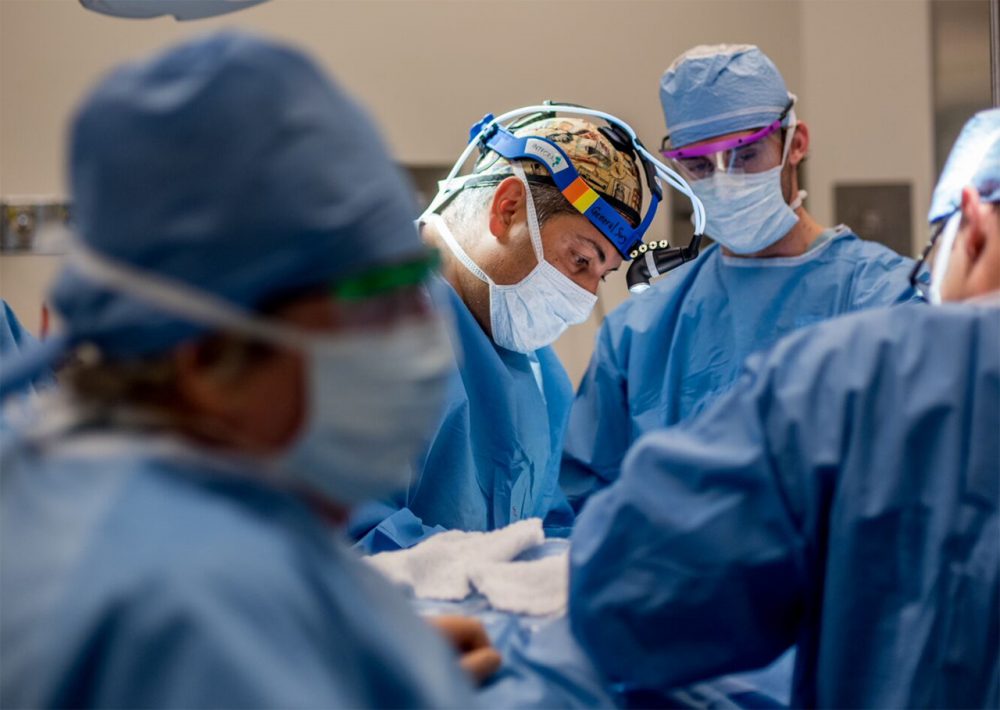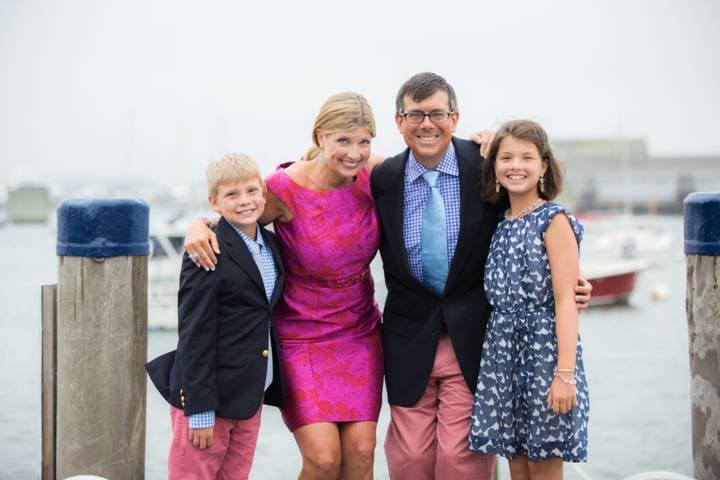Advertisement
'Medically Unnecessary, But A Choice:' Tripling Of Women Who Have Healthy Breast Removed

As Ellen Collins lay on the operating table, her mind beginning to fog over from the anesthesia, the surgeon who was about to perform her double mastectomy offered encouraging words: “I will meet you at the top of Vail Mountain.”
Three years later, when Collins marked the joyous milestone of surviving her aggressive breast cancer beyond the worst danger zone, the surgeon kept his word. Dr. Mehra Golshan and his family did indeed meet her at the top of the mountain to celebrate — and ski down.
That was back in 2013, and Collins remains grateful to this day. She has not a single regret about her double mastectomy and the reconstruction that followed.

“The peace of mind and the quality of life — I feel whole again, I feel complete,” she said. “I can look in the mirror and not feel deformed. I feel proud of myself and I feel healthy — it’s priceless.”
And Dr. Golshan, who is distinguished chair in surgical oncology at Brigham and Women’s Hospital, remains supportive of her choice. But he is also concerned about the trend she represents.
The number of women who have cancer in just one breast but choose to have both breasts surgically removed is rising ever more dramatically. From 2002 to 2012, the rate tripled, according to newly published research that Golshan oversaw.
Among the nearly half a million American women diagnosed with early invasive breast cancer during that time, double mastectomies rose from about 4 percent of patients to over 12 percent. And those numbers pre-date the boost from Angelina Jolie’s 2013 announcement of her own surgery.
Here’s the crux of the problem: For 90 percent of those women, those who lacked a clear genetic risk, the data show that double mastectomies did not improve their long-term odds of survival. That lack of survival benefit has been clear for years, but they underwent the major operation anyway.
“The number one concern for my patients is survival,” Golshan said. “And if I can’t say that removing the opposite breast is going to achieve that, well, is that something a woman should go through? And it’s a very difficult and a very personal decision, but our research is basically showing that if anything, it’s increasing, and not slowing down.”
‘I Don’t Want This Coming Back’
Why would more and more women be choosing an operation that involves a long recovery and carries risks that include recurrent infections, chronic pain and the need for more surgery?
Golshan’s own study offers a major clue: Far more women who have mastectomies are also undergoing breast reconstruction. The rate has risen from 35 percent in 2002 to 55 percent in 2012. Reconstruction itself has been improving significantly, he said.
So for a patient like Ellen Collins, a double mastectomy combined with reconstruction offers a double appeal.
The mastectomy left her feeling like she had done everything she could to reduce the risk of a recurrence, she said. Her children were in kindergarten and second grade when she was diagnosed at age 41.
“In a cancer situation, so much is out of your control,” she said, “but this was one piece that I could say with conviction that I want to do for me, and the main point is, I don’t want this coming back.”

The reconstruction also gave her breast “parity” — so now, in a sales job in which appearance is important, “I feel confidence in anything I wear. I was able to get my life back.”
Also a possible factor: Rising public attention to breast cancer, including celebrities like Jolie who are open about their operations and model good outcomes.
Yet another possible factor: The findings on the lack of a survival benefit don’t make intuitive sense. If your diagnosis shows you’re prone to breast cancer, it seems obvious that removing a breast should lower risk.
But the risk of cancer in the opposite breast is extremely low, Golshan explained, and if cancer does develop there, it will likely be caught early. The greatest danger is cancer coming back elsewhere, in a woman’s lungs or bones or brain, he said.
And then there’s insurance: American health insurance generally covers “contralateral prophylactic mastectomy and reconstruction” — removing the healthy breast and doing a double reconstruction — even though the costs may amount to tens of thousands of dollars more than less involved options.
‘It’s Medically Unnecessary, But It’s A Choice’
So with all the factors in favor of preventive mastectomies, why all the concern from Golshan and other cancer specialists?
“From a medical perspective, this is a medically unnecessary surgery for most women,” explained researcher Shoshana Rosenberg of the Susan F. Smith Center for Women’s Cancers at Dana-Farber. “Because it does not improve your outcome, it does not improve your survival. So you’re doing an aggressive medical procedure that doesn’t really improve a medical outcome — that’s the concern.”
“At the same time,” she said, “you want to empower women to be in charge of medical choices, and for some women it might be the right decision. So you have that tension — it’s medically unnecessary, but it’s a choice.”
Note: For women with BRCA mutations, which dramatically raise the risk of breast and ovarian cancer, some studies suggest there is a medical benefit: a double mastectomy does seem to improve their survival odds.
But recent research by Rosenberg and colleagues found that among women under 40 diagnosed with breast cancer, more than half of the patients who tested negative for BRCA mutations nonetheless opted for double mastectomies.
Dr. Shelley Hwang, chief of breast surgery at the Duke Cancer Institute, recently expressed the concern about “contralateral prophylactic mastectomies” like this in The Washington Post: “Breast surgeons as a community are very worried about women using this kind of surgery to alleviate anxiety,” she said. “Surgery is meant to cure a biological problem, not make people feel less anxious.”
Still, the specialists and researchers who are raising concerns about contralateral mastectomies are not calling for the option to be taken away.
"If you leave the breast on...do you think, really, that you will be seriously poisoned by chronic worry and stress over time?"
Rather, they argue that more research is needed to improve breast cancer surgery decision-making. Rosenberg, of Dana-Farber, is doing just that — analyzing the factors at work in these decisions.
Research has already found that women are likelier to choose double mastectomy if they’re younger, she said, and if they’re white. Now the challenge is to get deeper into their decision-making.
One possible motivation, she said, is that younger women in particular want “to feel like you’ve done everything possible to take care of the breast cancer. And sometimes that means doing or being the most aggressive you can be, even though that doesn’t necessarily improve your outcome.”
It’s well known that we humans have a hard time wrapping our minds around risk and probabilities when we have to make decisions — particularly when emotions are running high.
“So I think it’s this complex interplay of emotions and having to process a lot of information when you’re newly diagnosed,” Rosenberg said. “That’s part of it.”
Ultimately, she said, the plan is to develop a “decision aid” — a tool to help newly diagnosed patients talk with their doctors about surgical options, “ensuring they’re supported and making an informed decision.”
‘You Face Two Potential Harms’
For a sense of what that conversation could eventually sound like, I turned to David Ropeik, an instructor at Harvard who is an expert on risk communication and author of “How Risky Is It Really? Why Our Fears Don’t Always Match The Facts.”
He pointed out that breast cancer carries a particularly high fear factor because it’s so often in the news, and people still tend to see “the C word” as a likely death sentence, one that involves pain, suffering and powerlessness.
Choosing a double mastectomy when it will not improve survival odds can seem like “self-harm,” he said. But chronic, toxic stress stemming from worry about cancer can be bad for you too. So he suggests a script for a doctor that goes something like this:
“You face two potential harms with this choice. One is to leave your other breast alone, because there’s no clinical reason to remove it, but deal with fear, which causes stress, which has health effects, but which you can, and over time you will, deal with. You will go on with your life, and most of the time you won’t be thinking about that.
"Or you can have your other breast removed, with all the physical complications of that and the potential — low but real — for side effects. That’s the other harm that you face. The disfigurement, although there are prosthetics, and the potential complications of surgery, to do something that is not clinically called for but which has the benefit of removing the stress.
"So the question you really need to ask yourself is: If you leave the breast on — be very honest, over the course of your life, continuing to have your breast examined to make sure there’s nothing popping up and doing other things to deal with the stress — do you think, really, that you will be seriously poisoned by chronic worry and stress over time? Not just now, when it’s really scary, but over time?
“If you think that you can adjust to that stress, and it really won’t cause you a lot of harm, then the choice focuses back on doing something that’s not clinically called for, which has potentially negative physical side effects, just because you’re afraid.”
The challenge is to frame the question for the patient, Ropeik said, “but you’re not answering and you’re not advising. That’s the most important part of the risk communication conversation, in this case and in most cases: to frame things in a sympathetic way, a supportive way, a clarifying way, but not a way that prescribes how the person should feel or decide.”
“That’s up to them,” he went on. “This is a very personal thing in the end, and no doctor or medical provider can really make that call for people. And the more they acknowledge that in how they deal with people, the more their framing will carry weight with that patient.”
Readers, thoughts, reactions? Would this sort of conversation work for you?
